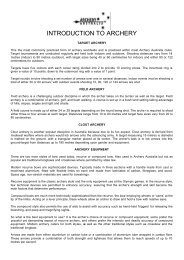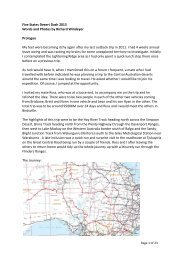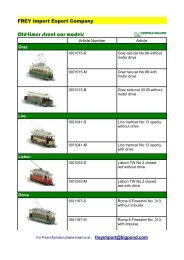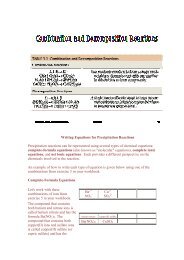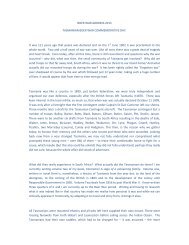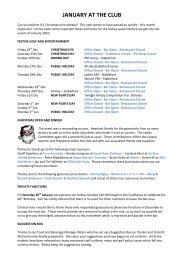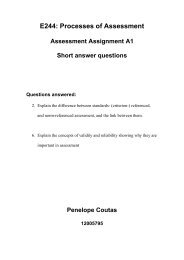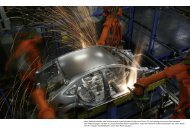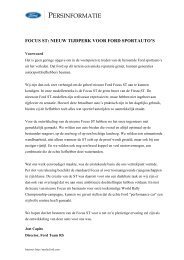Pistol Reloading for Beginners
Pistol Reloading for Beginners
Pistol Reloading for Beginners
You also want an ePaper? Increase the reach of your titles
YUMPU automatically turns print PDFs into web optimized ePapers that Google loves.
<strong>Pistol</strong> <strong>Reloading</strong> <strong>for</strong> <strong>Beginners</strong><br />
The relatively cheap and simple method<br />
Are there advantages to loading your own ammo?<br />
Well, it really depends on what you need in your pistol<br />
ammo.<br />
Your choices, without reloading your own, are usually<br />
factory ammo or club reloads.<br />
Factory ammo is manufactured specifically to operate<br />
safely in any pistol of that calibre. There<strong>for</strong>e it is<br />
usually loaded to the maximum safe pressures allowed.<br />
This is to ensure all pistols of that calibre will operate<br />
reliably.<br />
As most pistols today are semi-automatic and rely on<br />
recoil or gas pressure to cycle the action, it is critical<br />
that factory ammo is loaded with high enough pressure<br />
to suit a wide variety of pistol brands.<br />
Typical Factory Ammo, about $40 <strong>for</strong> a box of 50<br />
rounds<br />
Club reloads on the other hand are intended to be<br />
much cheaper than factory loads and are loaded to the<br />
minimum pressure it takes to operate most club<br />
handguns. By keeping pressures relatively low the<br />
brass cases can be re-used many times, greatly<br />
reducing the cost of ammunition as the brass case is<br />
the most expensive component.<br />
The most obvious benefit is the reduced cost, and it’s<br />
very worthwhile one as reloading your own can be<br />
around one quarter the cost of factory ammo.<br />
Club Reloads, no fancy box and re-used brass,<br />
about $20 <strong>for</strong> 50<br />
But there’s another less obvious benefit, it allows you<br />
to tailor your loads to what gives best accuracy, and/or<br />
minimum recoil, in your firearm. For competition<br />
shooters this is just as important as the cost. Being<br />
able to tailor your loads to what works best in your gun<br />
can make quite a difference in your scores.<br />
<strong>Reloading</strong> your own requires a small amount of<br />
equipment, a small area set aside in which to operate,<br />
a reference library of reloading info and most<br />
importantly a good attention to detail and accuracy.<br />
If you think this applies to you, read on.<br />
<strong>Reloading</strong> presses are often available as a complete kit<br />
with everything to get you started, such as this Lee<br />
Classic Turret Kit (refer to the text)<br />
<strong>Pistol</strong> <strong>Reloading</strong> 2.docx<br />
PWD 26Jun13
So how much do you need to invest to get setup <strong>for</strong><br />
reloading? That depends on how much ammo you<br />
need. If you’re short on time and need hundreds of<br />
rounds each week, then you need to go straight to a<br />
high end reloading press, like those made by Dillon.<br />
A Dillon XL650 (a very popular reloading press with<br />
action shooters, <strong>for</strong> example) can pump out over<br />
600 rounds per hour, but your investment can be<br />
well over a $2000 by the time it’s fully equipped.<br />
Many of us don’t need anywhere that many rounds<br />
per hour and our reloading equipment budget is<br />
also much smaller. What follows is a proven and<br />
simple method of how to get accurate ammo, <strong>for</strong> a<br />
minimum outlay.<br />
<strong>Reloading</strong> presses with auto indexing (they<br />
progressively move to the next round or next<br />
station with each pull of the handle) are good value<br />
<strong>for</strong> pistol reloaders, however the faster and more<br />
complicated presses tend to have 4 or 5 operations<br />
happening simultaneously, with each pull of the<br />
handle.<br />
Presses come in many shapes and sizes, from left to<br />
right – Dillon XL650, Lee Loadmaster, Hornady Lockn-Load<br />
AP and RCBS Pro 2000 – all are 5 station<br />
progressive presses. Fast, but complex and costly.<br />
When you’re new to reloading this makes it very<br />
difficult to keep track of your quality control<br />
because you can easily develop a problem, or run<br />
out of one ingredient (powder, primers or cases)<br />
be<strong>for</strong>e you notice and end up creating some dud<br />
loads.<br />
So if you’d like to have more control over what’s<br />
happening (only one thing happening at a time) and<br />
you’re happy with making around 100 to 200<br />
rounds per hour, here is a simple way to get into<br />
reloading.<br />
Shown at right is a 4 stage Lee Turret Press fitted<br />
with a Lee Pro Auto-Disk powder measure (red<br />
cylinder at the top) and an RCBS primer system<br />
(long, thin, almost vertical aluminium tube). It is<br />
progressive in that the turret (with the dies) rotates<br />
90 degrees each time the handle is pulled.<br />
Only one case is in the press at a time, so it takes 4<br />
pulls of the handle to complete each round, but it<br />
allows you to see each and every operation so you<br />
have greater control over the quality of your<br />
reloads.<br />
Lee Turret press about 20 years old and has done<br />
tens of thousands of rounds. Not as fast as full<br />
progressive presses, but easy to setup, simple to<br />
maintain and accurate.<br />
<strong>Pistol</strong> <strong>Reloading</strong> 2.docx<br />
PWD 26Jun13
RELOADING STEPS<br />
First step in reloading is to clean your fired brass. This<br />
prevents undue wear on your dies and pistol barrel<br />
chamber. A tumbler, like this Lyman brand, using crushed<br />
corn cob or walnut shell media, will give nice clean, shiny<br />
brass after a couple of hours of gentle vibration.<br />
After you’ve set up your press and dies using the<br />
instructions that come with them; load a clean case into<br />
the shell holder. Position the de-capping and resizing die<br />
above the case. Raising the press ram will now <strong>for</strong>ce the<br />
case into the die which will resize it and also push out the<br />
used primer.<br />
While press ram is up, the priming lever (“T” shape on this<br />
press) is moved away from the press to grab a fresh primer<br />
from the dispenser. Pushing the priming lever back toward<br />
the press positions it inside a slot in the ram, directly<br />
underneath the newly resized case. Photo shows new<br />
primer about to go into the ram slot. A downstroke of the<br />
press ram will now insert the primer into the case. Each<br />
downstroke of the press ram rotates the die head 90<br />
degrees to line up the next die in sequence.<br />
The next upstroke of the press ram will flare the case<br />
mouth to allow the new bullet to be easily inserted and<br />
drop the required amount of power into the case.<br />
What you DON’T<br />
want to see – no<br />
powder in case!<br />
Lower the ram, visually check there is powder in the case<br />
(a small desk lamp alongside your press is essential <strong>for</strong><br />
this). If you run out of powder or if a problem develops<br />
you will see it be<strong>for</strong>e you create dud rounds.<br />
If powder is present, insert the new bullet by hand. The<br />
next upstroke will seat the bullet to the required depth<br />
and remove the flare from the case.<br />
The fourth and last upstroke of the press ram runs the new<br />
round through the Lee Factory Crimp die, which again<br />
resizes the case to remove any bumps and lumps caused<br />
when inserting the bullet, and will also apply a crimp if<br />
required. Heavy loads in revolver or lever action rifle are<br />
usually crimped, where rounds <strong>for</strong> most semi-auto pistols<br />
are not.<br />
Check the loaded overall length of your newly reloaded<br />
round. This is a check on your die settings. Correct overall<br />
length is important <strong>for</strong> the pistol to load and function<br />
correctly.<br />
<strong>Pistol</strong> <strong>Reloading</strong> 2.docx<br />
PWD 26Jun13
RELOADING AREA & EQUIPMENT<br />
Your reloading bench need not take up a lot of<br />
room.<br />
This reloading bench is just 900mm by 450mm and<br />
it has containers <strong>for</strong> cleaned brass in 2 calibres<br />
(9mm and 38 Super here), projectiles of different<br />
weights (115, 125 and 135 grains) plus a spare head<br />
with dies and some tools <strong>for</strong> checking and<br />
adjusting.<br />
Changing calibres is very easy with this type of<br />
press. Here is another turret head already fitted<br />
with the 4 dies adjusted and ready to go, <strong>for</strong> 9mm<br />
Luger in this case.<br />
The black disk is a powder measure disk <strong>for</strong> the Lee<br />
Pro Auto-disk powder dispenser, which is just<br />
transferred from one turret to another. Changing<br />
the turret head, powder dispenser and disk takes<br />
about 1 minute.<br />
You will also need a powder measuring scale so you<br />
can check your powder loads (and projectiles),<br />
when setting up new dies, or <strong>for</strong> just checking your<br />
quality control each time you make changes or<br />
reload a new batch.<br />
Checking the powder<br />
measure setting.<br />
Three loads of 4.9-5.0<br />
grains being checked<br />
on an electronic scale<br />
Beam balance or electronic scales both work well.<br />
You will also need a set of calipers <strong>for</strong> checking<br />
loaded round overall length, when setting up new<br />
dies, or <strong>for</strong> just checking your quality control each<br />
time you reload a batch.<br />
Dial or electronic Calipers both work well.<br />
Finally you should use some proper ammo boxes in<br />
which to store your newly reloaded ammo. These<br />
are good <strong>for</strong> protection during transport and are an<br />
easy way to keep track of your rounds count.<br />
How much all up? The Lee Classic Turret Press Kit<br />
shown on page 1 (<strong>for</strong> example) has everything you<br />
need, except the dies (about $60 per set) calipers<br />
(about $40) and some ammo boxes ($6-$10 each),<br />
and will set you back about $350. Add a tumbler<br />
and you could be reloading good quality ammo <strong>for</strong><br />
around $600.<br />
And the cost of 50 pistol rounds<br />
reloaded with your labour, using new<br />
primers, powder and projectiles, and<br />
used brass cases? – around $11.<br />
<strong>Pistol</strong> <strong>Reloading</strong> 2.docx<br />
PWD 26Jun13



